About the Church
 |
 |
 |
 |
 |
 |
 |
The Holy Mass - Part V
How the Novus Ordo Missae
Destroyed the Tridentine Mass
The last article looked at the slow and steady changes made to the liturgy of the Mass by the Conciliar progressivists preparing for the Novus Ordo Missae. Here we will see the further and more radical destruction.
Two documents were promulgated on April 3, 1969, for the reform of the Mass:
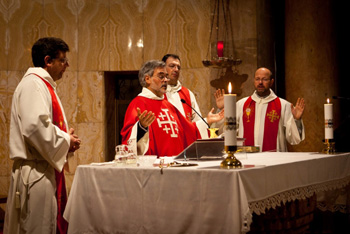 When the Novus Ordo Missae was first introduced, it was defined in the Institutio as “an assembly of the People of God under the presidency of the Priest.” There was no mention in it of the Mass as a sacrifice. Nor was there any mention of the dogma of transubstantiation. Incidentally, both omissions incur the anathema of the Council of Trent. Instead the Mass was presented as a memorial of the Resurrection and Ascension. (1)
When the Novus Ordo Missae was first introduced, it was defined in the Institutio as “an assembly of the People of God under the presidency of the Priest.” There was no mention in it of the Mass as a sacrifice. Nor was there any mention of the dogma of transubstantiation. Incidentally, both omissions incur the anathema of the Council of Trent. Instead the Mass was presented as a memorial of the Resurrection and Ascension. (1)
In his work In the Murky Waters of Vatican II, Atila Guimarães points out two other extremely important points of the Mass modified by the Novus Ordo: the Offertory and the Consecration, with innovations made to accommodate the Protestants.
In the Offertory in the Tridentine Mass, many prayers such as the Suscipe Sancte Pater, the Offerimus Tibi Domini, the Deus qui humanae substantiae and the Veni Sanctificator clearly show the propitiatory character of the Sacrifice. All these prayer were eliminated in the Novus Ordo. (2)
There was another essential modification in the formula of the Roman Canon, again to make the Mass more acceptable to Protestants. We saw in the last article the introduction of the three new Canons, which desacralize the Mass and remove its essential sacrificial character. In the Novus Ordo Missae, the Consecratory formula was changed and fused into the preparatory prayer of the Consecration Qui pridie, with the two together becoming “the Narration of the Institution.”
With this, Guimarães notes, “It is implied that the Mass has been changed from a Sacrifice to merely a memorial supper. Importantly, the form of the Consecration of the Holy Sacrifice of the Mass was definitively expressed at the Council of Florence in 1442, reiterated at the Council of Trent in 1545 and the Missale Romanum was codified by Pope St. Pius V in 1570 in the Bull Quo primum tempore.”
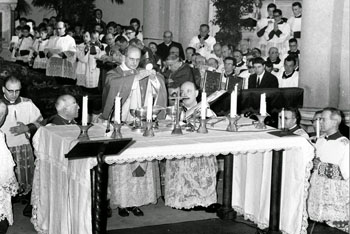 He continues: “The removal of the words 'mysterium Fidei' from the Consecratory formula of the wine in the Novus Ordo contradicts these two councils and Quo primum, and could appear to be a deliberate attempt to eliminate the sacrificial nature of the Mass. This facilitates an acceptance of the Novus Ordo by Protestants and places grave doubts about Transubstantiation in the minds of the Catholic clergy and laity. Doubts of this magnitude can without a question contribute powerfully to increase the extraordinary crisis of Faith that is shaking large parts of the clergy.”(3)
He continues: “The removal of the words 'mysterium Fidei' from the Consecratory formula of the wine in the Novus Ordo contradicts these two councils and Quo primum, and could appear to be a deliberate attempt to eliminate the sacrificial nature of the Mass. This facilitates an acceptance of the Novus Ordo by Protestants and places grave doubts about Transubstantiation in the minds of the Catholic clergy and laity. Doubts of this magnitude can without a question contribute powerfully to increase the extraordinary crisis of Faith that is shaking large parts of the clergy.”(3)
Thus, he concludes: “The heart of the Holy Sacrifice of the Mass has been profoundly modified by the Novus Ordo.”(4)
A futile Intervention
Naturally, the progressivists were pleased with the 1969 Institutio and Novus Ordo Missae, but the conservatives were not. On September 13, Cardinals Ottaviani and Bacci sent Paul VI the well-known Intervention titled Brief Critical Examinaltion of the Novus Ordo Missae.
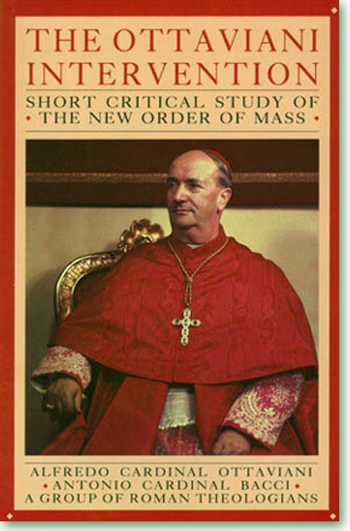 In it they stated that the New Mass “represented as a whole, and in its details, a striking departure from the Catholic theology of the Mass as it was formulated in session 22 of the Council of Trent, which erected an insurmountable barrier against any heresy that might attack the integrity of the Mystery.” (5)
In it they stated that the New Mass “represented as a whole, and in its details, a striking departure from the Catholic theology of the Mass as it was formulated in session 22 of the Council of Trent, which erected an insurmountable barrier against any heresy that might attack the integrity of the Mystery.” (5)
To deflect criticisms of this document, a revised General Instruction was issued on March 26, 1970, with a Prologue to the Institutio presenting some principles of Catholic doctrine absent in the 1969 version.
However, a careful study of this Prologue shows no essential modifications regarding the 1969 document, and no significant change was made in the text of the Novus Ordo Missae itself. (6)
There was not “a more acceptable form” or even partial victory with the 1970 Institutio and New Mass, as trumpeted by some traditionalist and conservative writers to curry favor with the Una Voce commission and authors of the Intervention.
Intent to destroy
Even in the original Latin form, the Novus Ordo was a doctrinal travesty that displayed its intent to destroy the Tridentine Mass. A total of 35 prayers or approximately 70% of the Tridentine Mass were replaced or discarded as well as many brief versicles and responses, more than 20 Signs of the Cross, 12 genuflections and multiple other acts of reverence.(7) Thus the break with Sacred Tradition and Dogma was accomplished.
It should be recalled that the authors of this travesty were the members of the committee called the Consilium headed by Archbishop Bugnini, whose Freemasonic connections are almost certain to be real. Assisting the group were six Protestant observers, whom Paul VI publicly thanked for their help in “re-editing in a new manner liturgical texts … so that the lex orandi (the law of prayer) conformed better with the lex credendi (the law of belief).” (8) One can only wonder how Protestant heretics could offer any help in formulating the very rite that they rejected…
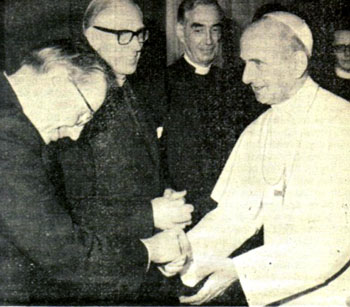 In conclusion, it should be noted that the Novus Ordo Missae of Paul VI in 1969 is remarkably in agreement with the Anglican Mass of Cranmer in 1549. An analogous procedure of gradual changes was also used to prepare the faithful to accept the dramatic changes and the explicit heresy of Anglicanism.(9)
In conclusion, it should be noted that the Novus Ordo Missae of Paul VI in 1969 is remarkably in agreement with the Anglican Mass of Cranmer in 1549. An analogous procedure of gradual changes was also used to prepare the faithful to accept the dramatic changes and the explicit heresy of Anglicanism.(9)
With over 95% of the Roman rite Masses in the world being Novus Ordo, traditional Catholics who have access to Tridentine Masses are indeed blessed.
The present Pope Bergoglio dislikes the Tridentine Mass and we must pray he will not abrogate it, an act that would ipso facto be invalid.
Sadly diocesan control forces priests who say the Tridentine Mass to say also the Novus Ordo Missae or the hybrid Mass requested by Benedict, resulting in chaos for them and their congregations.
Only when the Consecration of Russia to the Immaculate Heart of Our Blessed Mother is made as mandated at the great apparition at Tuy, Spain, on June 13, 1929, to Sister Lucia in the presence of the Holy Trinity and the Blessed Mother, will this general apostasy end. That request was made 86 years ago, and it is unlikely the present Pontiff – who never refers to Fatima and the Rosary – will make that consecration.
It is most likely we are facing the great Chastisement that was predicted to fall on an unfaithful world at Fatima and Quito. But we have the promise of Our Lady that then, after that great cleansing, the Catholic Church will be restored to its former orthodoxy, purity and beauty.
Continued
Two documents were promulgated on April 3, 1969, for the reform of the Mass:
- The Institutio Generalis, with 341 articles in which the new rites are minutely explained, and
- The text of the new Ordo Missae.

First, the priest-presider and concelebrants at a stripped altar; later, the people are invited to gather round
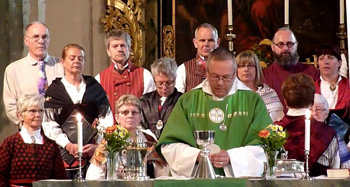
In his work In the Murky Waters of Vatican II, Atila Guimarães points out two other extremely important points of the Mass modified by the Novus Ordo: the Offertory and the Consecration, with innovations made to accommodate the Protestants.
In the Offertory in the Tridentine Mass, many prayers such as the Suscipe Sancte Pater, the Offerimus Tibi Domini, the Deus qui humanae substantiae and the Veni Sanctificator clearly show the propitiatory character of the Sacrifice. All these prayer were eliminated in the Novus Ordo. (2)
There was another essential modification in the formula of the Roman Canon, again to make the Mass more acceptable to Protestants. We saw in the last article the introduction of the three new Canons, which desacralize the Mass and remove its essential sacrificial character. In the Novus Ordo Missae, the Consecratory formula was changed and fused into the preparatory prayer of the Consecration Qui pridie, with the two together becoming “the Narration of the Institution.”
With this, Guimarães notes, “It is implied that the Mass has been changed from a Sacrifice to merely a memorial supper. Importantly, the form of the Consecration of the Holy Sacrifice of the Mass was definitively expressed at the Council of Florence in 1442, reiterated at the Council of Trent in 1545 and the Missale Romanum was codified by Pope St. Pius V in 1570 in the Bull Quo primum tempore.”

Paul VI says the first Novus Ordo Missae at the Vatican
Thus, he concludes: “The heart of the Holy Sacrifice of the Mass has been profoundly modified by the Novus Ordo.”(4)
A futile Intervention
Naturally, the progressivists were pleased with the 1969 Institutio and Novus Ordo Missae, but the conservatives were not. On September 13, Cardinals Ottaviani and Bacci sent Paul VI the well-known Intervention titled Brief Critical Examinaltion of the Novus Ordo Missae.

Ottaviani's Intervention caused no essential changes in the form of the New Mass
To deflect criticisms of this document, a revised General Instruction was issued on March 26, 1970, with a Prologue to the Institutio presenting some principles of Catholic doctrine absent in the 1969 version.
However, a careful study of this Prologue shows no essential modifications regarding the 1969 document, and no significant change was made in the text of the Novus Ordo Missae itself. (6)
There was not “a more acceptable form” or even partial victory with the 1970 Institutio and New Mass, as trumpeted by some traditionalist and conservative writers to curry favor with the Una Voce commission and authors of the Intervention.
Intent to destroy
Even in the original Latin form, the Novus Ordo was a doctrinal travesty that displayed its intent to destroy the Tridentine Mass. A total of 35 prayers or approximately 70% of the Tridentine Mass were replaced or discarded as well as many brief versicles and responses, more than 20 Signs of the Cross, 12 genuflections and multiple other acts of reverence.(7) Thus the break with Sacred Tradition and Dogma was accomplished.
It should be recalled that the authors of this travesty were the members of the committee called the Consilium headed by Archbishop Bugnini, whose Freemasonic connections are almost certain to be real. Assisting the group were six Protestant observers, whom Paul VI publicly thanked for their help in “re-editing in a new manner liturgical texts … so that the lex orandi (the law of prayer) conformed better with the lex credendi (the law of belief).” (8) One can only wonder how Protestant heretics could offer any help in formulating the very rite that they rejected…

Paul VI greets Protestant observers at a meeting of the Consilium to reform the Mass
With over 95% of the Roman rite Masses in the world being Novus Ordo, traditional Catholics who have access to Tridentine Masses are indeed blessed.
The present Pope Bergoglio dislikes the Tridentine Mass and we must pray he will not abrogate it, an act that would ipso facto be invalid.
Sadly diocesan control forces priests who say the Tridentine Mass to say also the Novus Ordo Missae or the hybrid Mass requested by Benedict, resulting in chaos for them and their congregations.
Only when the Consecration of Russia to the Immaculate Heart of Our Blessed Mother is made as mandated at the great apparition at Tuy, Spain, on June 13, 1929, to Sister Lucia in the presence of the Holy Trinity and the Blessed Mother, will this general apostasy end. That request was made 86 years ago, and it is unlikely the present Pontiff – who never refers to Fatima and the Rosary – will make that consecration.
It is most likely we are facing the great Chastisement that was predicted to fall on an unfaithful world at Fatima and Quito. But we have the promise of Our Lady that then, after that great cleansing, the Catholic Church will be restored to its former orthodoxy, purity and beauty.
Continued
- Atila S. Guimaraes, In the Murky Waters of Vatican II, Maeta: 1999, pp. 234-235.
- Ibid., pp. 230-233
- Ibid., pp. 233-234.
- Ibid., p. 234.
- The Ottaviani Intervention: A Critical Study of the New Mass, online edition
- A. Guimaraes, In the Murky Waters of Vatican II, p. 226.
- Fr. Paul Trinchard, Novus Ordo Condemned, Metairie LA: MAETA. 1997, p. 34.
- A. Guimaraes, In the Murky Waters of Vatican II, p. 260.
- This similarity is reviewed in great detail Fr. Noel Barbara, "A Disquieting Similarity Between the Protestant Reforms of 1549 and the Reforms of Paul VI Since Vatican II" Fortes in Fide, No. 12, 1983.

______________________











